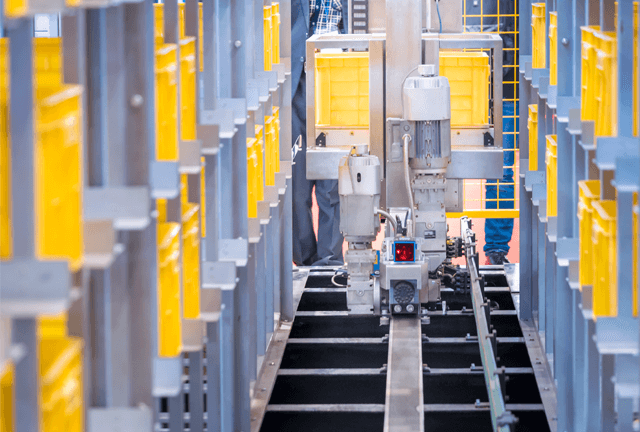A lot of companies around the world are making huge investments in automated warehouses targeting significant cost reductions. What they don’t realize is that it’s not enough to build the automated warehouse, it has to be integrated into a global operational landscape. Read on to discover why this is a critical piece in your automated warehouse strategy.
A global trend these days is to invest in fully or partially automated warehousing facilities. What companies are looking for with these investments is basically cost reduction: reduce occupied building spaces (space is cost!), reduce labour (labour is cost!) and optimize picking and put away time (time is money!).
There are several types of Automated Warehouses, and the choice between them is mostly driven by the cost and the type/size of the material you want to store (example: pallets, boxes or items/pieces).
Processware has case studies with mainly 3 kinds of equipment: Vertical Lift Module; Cubical Automated Warehouse and Transelevator.
-
The Vertical Lift Module (or VLM) is a shelf driven system, where the shelfs (or trays) are delivered to the operator. Typically, each tray stores several bins, and because those trays are stacked in a very compact fashion, it can reduce the occupied space by 80% when compared to conventional warehouses. This kind of equipment is usually recommended for small parts or boxes. You can find our more about this equipment here.
- The Cubical Automated Warehouse is an example of a box warehouse system. These boxes are stacked on one another, and a set of robots have access to the upmost boxes to taken them to an operator, or to unstacked them so that they have can access lower boxes. This kind of equipment lets you save 60% of the occupied space, and increases the operator productivity up to 50%. Know more here.
- The Transelevator is the most classical example of large dimension items automated warehouse, usually used for pallets and large boxes. The robots are guided by trails through narrow aisles (these aisles are not much wider than the item itself), reaching for heights hardly reachable by common forklifts. This way, it’s possible to have high returns in space reduction and productivity. Learn more here.
If the automated warehouse executes every task, then we won’t have more accuracy problems, right? Wrong!
Although we are automating the majority of the tasks, we are not taking people out of the whole operation. And people fail! The most common example is the picking activity: typically, the warehouse will bring a bin, and it will indicate the quantity that should be picked by the operator. If the operator fails counting the material (and eventually he fails!), the stock accuracy will drop, and procurement and production planning will suffer from that.
It’s “just” put away and pick, so it must be easy!
Although the automated warehouse’s technologies are mature (regarding hardware), it’s not trivial to incorporate this equipment in well-established conventional operations. The biggest challenge is related to the ERP integration with the warehouse control system. The most common mistake is trying to incorporate the business rules and constraints into the warehouse control system.
A practical example is the large diversity of distinct picking processes: picking for production, picking for shipping (domestic/international), picking for plant transfer, etc. Each of these processes have distinct procedures inside the ERP system, and it can become a maintenance nightmare inside the warehouse control system to know all the ERP business rules.

Processware was called to participate in several automated warehouse projects with that clear goal: try to simplify the integration. The warehouse control system only has to store and retrieve material. All the business rules are kept in an operational platform, which allows the rules to change over time, without affecting the operations. This operational system should map the business requirements with the automation and operational needs. This kind of solution also allows the ERP to be unaffected by the incorporation of different kinds of automated warehouses, with their special needs and requirements.
This post is just an introduction to this subject. In the next few weeks we will have the opportunity to discuss more deeply issues like prioritization, grouping, synchronization and standardization.